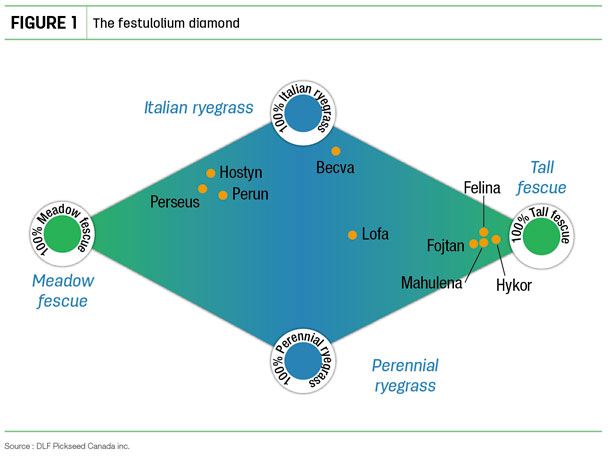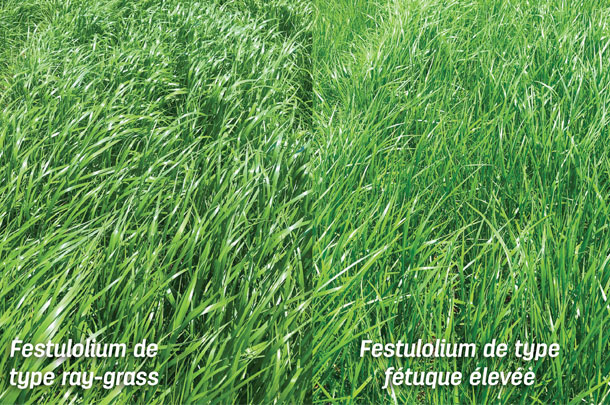Festulolium varieties are split into two main groups: ryegrass types and fescue types. Until recently, only the ryegrass type was available in Canada. With both types now offered, it is important to know how each one addresses very different needs.
The festulolium diamond, as shown in Figure 1, depicts the various crosses to obtain a festulolium hybrid and where they fall in the two main groups.

Festulolium may be derived from annual or perennial ryegrass crossed with tall or meadow fescue. Depending on the characteristics retained, it will tend to be more like fescue (green zone) or more like ryegrass (blue zone).
Every festulolium type is unique in its traits. Understanding these traits will help you choose the appropriate type to fit your specific requirements.
Ryegrass-type festulolium
Morphologically resembling its ryegrass parent, this festulolium may replace Italian ryegrass, hybrid ryegrass and perennial ryegrass in mixes to attain up to three years of persistency.
Its tolerance to different stresses, drought, diseases and early frost make it a better choice regarding yield and persistence than ryegrass varieties.
This type can be used as a companion crop with a low seeding rate (0.8 to 1.6 kilograms per acre). With some precipitation and appropriate nitrogen fertilization, ryegrass-type festulolium offers a high yield and a certain amount of weed suppression within its first year.
It will not head in its establishment year; however, in following years, it will head approximately every 21 days. To avoid feed value losses, especially in mature stands, frequent cuts are recommended.
In high-moisture conditions, especially in the fall, there is a risk of rust – but less than ryegrass. An application of potash, combined with frequent cuts, will help control the pathogen.
Another possible use of the ryegrass-type festulolium is as an emergency forage, especially following an alfalfa winterkill situation.
Its fast establishment and regrowth rate, as well as good fibre digestibility, makes it a viable option. Seeded at a rate of 10 kilograms per acre, it will fill the needs for forage in the seeding year.
To prolong its use in the following year, an evaluation of the population, proper fertilization and overseeding might be required.

Fescue-type festulolium
Resembling its fescue parent, it adapts well in stressful growing scenarios, especially in the summer.
With a higher yield and persistence, it can be used to replace tall or meadow fescue, as it will improve feed value in mixes for intermediate or long-term stands.
The usual coarseness of tall fescue leaves is not present in festulolium, which greatly increases forage palatability. Harder to dry, it is better harvested as silage or wrapped bales.
In a dry season, you may try to harvest it for dry hay, especially if mixed with bromegrass, timothy or orchardgrass. Much like its parent fescue, establishment is slow. It will only significantly contribute to the harvest by August but will last longer than ryegrass types.
This type of festulolium also works well for intensive management with alfalfa because it offers very high yields, excellent fibre digestibility and good persistence.
Whatever festulolium you choose, the size of the seed requires the use of appropriate seeders, such as equipment fit for bromegrass. Direct seeders or air-assisted planters also work very well.
Understanding the differences among festulolium types can help growers correctly choose the right type to fill their needs.
No matter the type, all festulolium types are a grass and require adequate moisture for germination and proper nitrogen fertilization. ![]()
PHOTO: Not all festuloliums are the same. Knowing the differences between the two types of groups can help in selecting the variety that will work best. Photos courtesy of DLF Pickseed Canada Inc.

-
Brigitte Lapierre
- Agronomist, Western Quebec
- DLF Pickseed Canada Inc.
- Email Brigitte Lapierre









